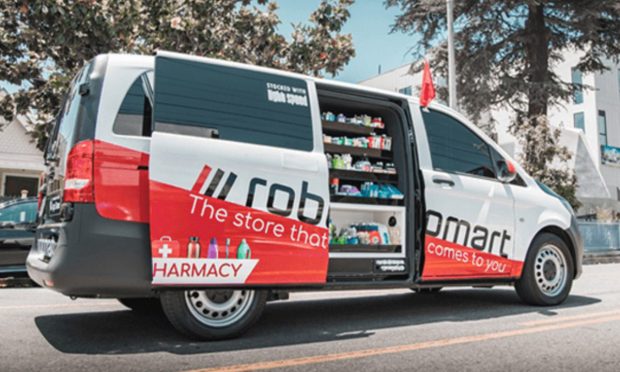Robomart Combats Basket Fatigue by Bringing the Convenience Store to Consumer’s Door

Today’s consumers want their food needs — restaurant and grocery alike — fulfilled faster than ever. Businesses are now competing to meet consumers’ food needs almost as soon as they arise, offering 15-minute grocery deliveries by bike or testing out autonomous solutions like drones or sidewalk robots.
See also: Flytrex CEO On Drone Food Delivery: ‘There’s No Better Way’
Tortoise Shifts Focus Of Automated Delivery To The Present
Robomart, a company that creates mobile shops that can be hailed through an app like an Uber or Lyft ride, is taking a different approach. Rather than focusing on getting consumers’ orders quicker, it cuts out the digital basket assembly step and brings the entire store to consumers.
“It gives consumers a way to get goods in the fastest possible way,” Robomart Co-founder and CEO Ali Ahmed told PYMNTS in an interview, noting that the model eliminates the friction of putting together an online basket. “Customers tend to spend over 20 minutes creating a basket, some cases can take up to an hour and a lot of customers get frustrated, and just stop … That’s where you see the most drop off — when customers are trying to put together a grocery basket.”
Last week, the company announced its retailer platform, allowing retailers to utilize the technology to create their own branded mobile shop. By the end of 2022, retailers across six categories — snacks, grocery, pharmacy, cafe, ice cream and fast food — will be able to utilize the technology. Contrary to what the company’s name implies, Robomart’s vehicles are not autonomous, though the company intends to launch driverless vehicles in the future.
Need for Speed
The company launched its fleet in West Hollywood in June. Ahmed notes that the shortest transaction on record, from hailing to payment, is 1 minute and 51 seconds.
“The average across all orders is nine minutes,” he said. “That is the entire end-to-end experience, from the time you open the app to the time you have products in hand.”
He added that the goal is for each vehicle to fulfill five to six orders per hour, which, he said, “is something that delivery services cannot do.”
To that end, the company views its competitors as the emerging delivery services that promise to deliver orders in as little as 10 minutes, though he argues that, by eliminating basket assembly time, Robomart is the clear winner when it comes to instant convenience.
The Familiar Unfamiliar
Given that this model is fairly new to most consumers — the company describes itself as “the world’s first store-hailing service” — Robomart is quick to take advantage of consumers’ comfort with rideshare apps to create a familiar experience.
“The whole app experience is reminiscent of ride-hailing services,” said Ahmed. “You see a map, you see the Robomarts, and then you can handle the particular Robomart that you want to hail.”
He added that consumers can browse the inventory in advance through their apps and that, when the vehicle arrives, the driver is blocked from view with tinted windows, such that the consumer’s only interaction is with the technology.
The Road Ahead
In the year ahead, the company will roll out café and fast food delivery, putting it in competition with major third-party delivery services such as DoorDash and Uber Eats.
The bring-it-to-me prepared foods market is on the rise. Where once delivery made up only a small fraction of total food orders, data from the PYMNTS 2021 Restaurant Readiness Index, created in partnership with Paytronix, find that 12% of quick service restaurant (QSR) sales come from online delivery orders, and 18% come from third-party aggregators.
Related news: QSRs’ Lagging Loyalty-Reward Investment Hurts Innovation And Sales
Ahmed hopes the company will be in “every major city across the world” within the next several years.
“I think that Robomart has the potential as the leader and pioneer of the space,” he said. “We’re the only ones who have created a store-hailing model … We can replicate what we’ve done in LA across numerous cities in the U.S. and overseas, and so the goal is to expand aggressively, and in the next five years be in every major city.”
